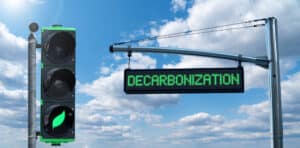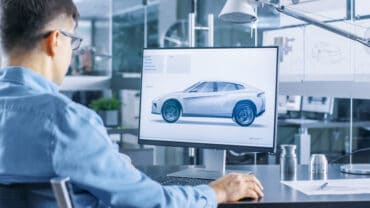
Electrification, digitization, and other technologies will play critical roles in reaching 2025 climate decarbonization goals.
A report conducted by the Intergovernmental Panel on Climate Change (IPCC) revealed an alarming truth — if the world wants to limit global warming to 1.5°C, global greenhouse gas emissions must peak before 2025 at the latest and fall at least 43% by 2030. The report also makes it abundantly clear that immediate and drastic cuts to emissions are necessary across sectors to reach these goals, requiring cooperation and stable commitments from both the public and corporate spheres.
It is widely agreed that speeding up the decarbonization of buildings will play a vital role in reaching climate goals. This is why the recent Inflation Reduction Act (IRA), billed as the largest climate legislation in U.S. history, brought new incentives for commercial energy efficiency tax deductions that make a commitment to sustainability an especially beneficial business proposition. These tax deductions are expected to help building owners and developers make energy-efficient improvements to speed the decarbonization of commercial real estate. The legislation also includes up to 50% in investment tax credits and higher production tax credits for on-site clean power development. Its goal is to help the U.S. trim greenhouse gas emissions by 40% below 2005 levels to start the next decade.
Organizations are not only incentivized to reach climate goals due to government regulation and funding but also because climate change has been proven to have a direct effect on their bottom lines. It begs the question – what does the 2025 deadline mean for business leaders who are making decisions about sustainability goals and strategies for decarbonization?
To realize these crucial climate goals, businesses should focus on two key areas: making greener building choices and using electricity as the best path to decarbonization.
See also: Tackling Industrial-Scale Decarbonization Efforts with AI
A Tale of Two Building Types: New Builds and Retrofits
Buildings are responsible for 37% of global CO2 emissions. Business leaders should focus on reducing carbon emissions in building operations and begin utilizing carbon offsets to balance any remaining emissions. However, the best approach to create net zero carbon buildings differs for existing buildings and new builds.
Since around half of today’s building stock is likely to be in use in 2050, rising up to 80% in developed economies, one of the greatest opportunities to reduce building-related carbon emissions lies in the existing building stock. In fact, older buildings are more likely to use traditional carbon-intensive energy sources than newer ones. Electrification and digitalization of existing buildings can make a dramatic difference in reducing overall emissions and energy waste. Upgrading management building systems and energy monitoring systems with the digital technology that exists today is required to make decarbonization possible.
In new building construction, companies can design their infrastructure with sustainability in mind to create a clean, green building from the ground up. Organizations should work with architects, consulting engineers, and contractors who focus on sustainable building design and construction from the start of the design process to determine what solutions will help them meet sustainability goals. This will often include building management and energy monitoring systems that can be included in the design process and will help monitor and regulate the energy use of a building for years to come.
See also: Climate Change Negotiations Could Be Empowered by AI
Using electricity as the best path to decarbonization
Global energy demand will only continue to grow, driven by population, economic growth, and electrification. As the global energy crisis looms large, we must speed up progress on renewable energy sources to meet rising demand and curb emissions.
Electricity is the most efficient energy source, and estimates show that renewable energy-generated electricity will rise 169% by 2040. Replacing heating that uses fossil fuels with electric heat pumps or electrifying operations to allow for electric vehicle charging are both great options to help meet neutrality goals. This requires a sophisticated, responsive load management system to manage electric technology with high demand spikes.
Microgrids are a critical part of the buildings decarbonization strategy, creating a more resilient energy market and enabling building owners to offset high electricity prices. With their help buildings become energy autonomous and stop taking power from the grid during high-priced periods – which is critical in a time of energy crises. Microgrids can also provide the charging infrastructure required to support the widespread adoption of electric vehicles (EVs), especially when there are constraints on the grid. This is particularly true in cities and in the wake of increasing extreme weather events. These changes to drive efficiency on the demand side will ease pressure on the supply side as we transition to a more electric world.
Decarbonization: You can’t manage what you don’t measure
Electrification and digitization are key to reaching decarbonization goals. Electricity makes energy green and provides a vital alternative to fossil fuels. As 60% of energy today is lost or wasted, and most buildings waste up to 30% of their energy, digitalization allows us to make energy more visible, drives efficiency, and helps reduce energy waste. Through IoT, data analytics, and artificial intelligence, all the systems within a building can be connected and digitalized to make smarter energy decisions.
The expression, “You can’t manage what you don’t measure,” is as valid for decarbonization as any other metric. Organizations can reduce carbon emissions through accurate and continuous energy monitoring by integrating modern building, power, and enterprise energy management systems with connected IoT devices. For example, with connected room-level sensors, a company can reduce energy through demand-driven HVAC and lighting control, only using heating and cooling when and where needed for occupied spaces.
The UN has described climate change as “a code red for humanity.” As the urgency for climate action intensifies, the number of net zero targets being set continues to skyrocket. Organizations today, public or private, need to think about climate change as a serious threat, not only to their bottom lines but to humanity as a whole. Each step on the path to decarbonization can pose significant challenges and requires considerable attention and effort, but today’s technological advancements make decarbonization more accessible and affordable than ever.




























